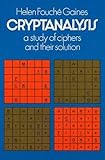Found in 3 comments on Hacker News
todd8 · 2016-07-12
· Original
thread
Thanks for the comments. I thoroughly enjoyed Between Silk and Cyanide. A small correction, the Playfair is actually a substitution cipher (mapping diagrams to diagrams) not a transposition cipher. The Playfair is a paper and pencil cipher that can usually be broken by hand with even modest amounts of material[1]. The Playfair (and the Wheatstone bridge) were invented by Sir Charles Wheatstone.
[1] Helen F. Gaines, Cryptanalysis, chapter 21. https://www.amazon.com/Cryptanalysis-Study-Ciphers-Their-Sol...
jgrahamc · 2013-05-03
· Original
thread
This is a very simple code to break. Helen Fouché Gaines' book Cryptanalysis (published in 1939) is a good introduction : http://www.amazon.com/Cryptanalysis-Study-Ciphers-Their-Solu...


In simple substitution a fixed mapping from the plaintext alphabet to the ciphertext alphabet is used for the entire message. This can easily be attacked by study of the frequency distribution of a message's intercepted ciphertext.
Simple substitution:
The Vigenère is an example of a polyalphabetic substitution . In polyalphabetic substitution ciphers, multiple mappings from plaintext to ciphertext are used throughout the encipherment of the message, thwarting simple frequency analysis. The Vigenère uses a particularly simple plan, a key selects which substitution mapping to use for each letter.Vigenère:
Here the key, "xyzzy", is short enough that any reasonable message will be broken easily with a paper and pencil attack. On the other hand, a key that is only used once and which is as long as the message makes the Vigenère equivalent to the unbreakable one-time pad ciphers.Many variations of the Vigenère make the cryptographer's work much more difficult. A scrambled tableaux (rather than the simple Caesar ciphers) or a key controlled by the message itself (called autoencipherment) present interesting but not difficult challenges.
When I was around 12 years old (1963) I was fascinated by codes and ciphers and my aunt gave me a book by Gains, titled Elementary Cryptanalysis[1]. I can't recommend it highly enough for those interested in the pre-computer treatment of ciphers. The book was best treatment of cryptography available to the public when it was originally published in 1939 and it covered the cryptanalysis of several important ciphers that had seen diplomatic and military use before World War II.
For example, Gains covers the important Playfair, Double Columnar Transposition, and Fractional Substitution, and Nihilist ciphers. A famous Soviet pencil and paper cipher that was never broken (the VIC cipher[2]) used a combination of the these last three.
[1] Gaines, Helen Fouche, Elementary Cryptanalysis, 1939. Republished by Dover under a slightly different title. This newer edition contains hint or solutions to the over 100 samples found in the original. https://www.amazon.com/Cryptanalysis-Study-Ciphers-Their-Sol...
[2] https://en.wikipedia.org/wiki/VIC_cipher